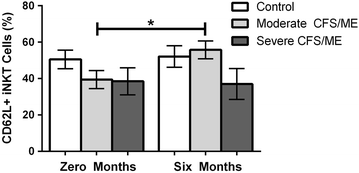Longitudinal analysis of immune abnormalities in varying severities of Chronic Fatigue Syndrome/Myalgic Encephalomyelitis patients
- PMID: 26370228
- PMCID: PMC4568602
- DOI: 10.1186/s12967-015-0653-3
Longitudinal analysis of immune abnormalities in varying severities of Chronic Fatigue Syndrome/Myalgic Encephalomyelitis patients
Abstract
Background: Research has identified immunological abnormalities in Chronic Fatigue Syndrome/Myalgic Encephalomyelitis (CFS/ME), a heterogeneous illness with an unknown cause and absence of diagnostic test. There have been no CFS/ME studies examining innate and adaptive immune cells longitudinally in patients with varying severities. This is the first study to investigate immune cells over 6 months while also examining CFS/ME patients of varying symptom severity.
Methods: Participants were grouped into 18 healthy controls, 12 moderate and 12 severe CFS/ME patients and flow cytometry was used to examine cell parameters at 0 and 6 months.
Results: Over time, iNKT CD62L expression significantly increased in moderate CFS/ME patients and CD56(bright) NK receptors differed in severe CFS/ME. Naïve CD8(+)T cells, CD8(-)CD4(-) and CD56(-)CD16(-) iNKT phenotypes, γδ2T cells and effector memory subsets were significantly increased in severe CFS/ME patients at 6 months. Severe CFS/ME patients were significantly reduced in CD56(bright)CD16(dim) NKG2D, CD56(dim)CD16(-) KIR2DL2/DL3, CD94(-)CD11a(-) γδ1T cells and CD62L(+)CD11a(-) γδ1T cells at 6 months.
Conclusions: Severe CFS/ME patients differed from controls and moderate CFS/ME patients over time and expressed significant alterations in iNKT cell phenotypes, CD8(+)T cell markers, NK cell receptors and γδT cells at 6 months. This highlights the importance of further assessing these potential immune biomarkers longitudinally in both moderate and severe CFS/ME patients.
Figures








References
-
- Brenu E, Johnston S, Hardcastle S, Huth T, Fuller K, Ramos S, et al. Immune abnormalities in patients meeting new diagnostic criteria for chronic fatigue syndrome/Myalgic Encephalomyelitis. J Mol Biomark Diagn. 2013;4(152.10):4172.
Publication types
MeSH terms
Substances
LinkOut - more resources
Full Text Sources
Other Literature Sources
Medical
Research Materials
Miscellaneous

